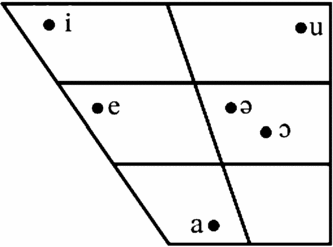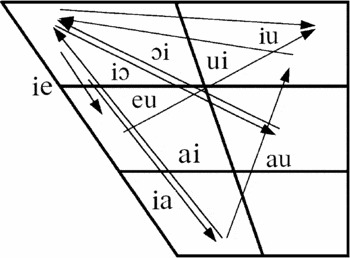Hakka Chinese is also known in China as Kejia dialect. The present study is based on phonetic data collected from native speakers of Hakka Chinese, male and female, aged between 18 and 22, during our field trips to Hakka-speaking Meixian County in the northeastern part of Guangdong Province in southeastern China in 2007. The speakers have lived all their life in Meijiang District of the county, speaking Meijiang variety which is considered representative of Meixian Hakka. The style of speech illustrated here is that typical of the educated younger generation and the recording is that of a 22-year-old male college student.
Consonants
Syllabic consonants
Vowels

Diphthongs

Triphthong

iau | siau˧ ‘to rid’
Tones (citation form)
Conventions
Consonants, syllabic consonants, vowels, diphthongs and triphthong
Syllable-initial [t th] are apico-laminal denti-alveolar; syllable-initial [s] is laminal alveolar; syllable-initial [ts tsh] are laminal alveolar or laminal denti-alveolar; syllable-initial [c ch ɲ] are lamino-anterodorsal alveolo-prepalatal or anterodorsal postalveolo-palatal; and [ç] is laminal prepalatal or anterodorsal palatal. All consonants occur in syllable-initial position, and only unreleased [p t k], i.e. [p˺ t˺ k˺], and [m n ŋ] occur in syllable-final position.
Syllabic alveolar approximant [![]() ]Footnote 1 is preceded only and obligatorily by homorganic [s ts tsh], and syllabic nasals [
]Footnote 1 is preceded only and obligatorily by homorganic [s ts tsh], and syllabic nasals [![]() ] and [
] and [![]() ] occur in isolation.
] occur in isolation.
VowelsFootnote 2 [i a e ɔ u] occur in open and closed syllables; and [ə] occurs only in closed syllables. [a] occurs before [p t k m n ŋ]; [i e ə] only before [p t m n]; and [ɔ u] only before [t k n ŋ]. [i u] are about cardinal in open syllables; [u] before [k ŋ] is slightly mid-centralized; [e] = [![]() ]; [a] = [
]; [a] = [![]() ]; and [ɔ] = [
]; and [ɔ] = [![]() ].
].
Diphthongs [ai au ui ɔi eu] occur only in open syllables; [ia iu] in open and closed syllables; and [ie iɔ] only in closed syllables. In closed syllables, [ia] occurs before [p k m ŋ]; [iu iɔ] before [k ŋ]; and [ie] before [t n]. [ia] = [![]()
![]() ]; [ai] = [
]; [ai] = [![]() i]; [ie] = [
i]; [ie] = [![]()
![]() ]; [au] = [
]; [au] = [![]()
![]() ]; [eu] = [
]; [eu] = [![]() u]; [ui] = [
u]; [ui] = [![]() i]; [iɔ] = [i
i]; [iɔ] = [i![]() ]; and [ɔi] = [
]; and [ɔi] = [![]() i].
i].
Triphthong [iau] occurs only in open syllables and is preceded by a large majority of the consonants, including a zero consonant. [iau] = [i![]()
![]() ].
].
Tones
Citation tone [˥] occurs only on checked syllables. Citation tones [![]() ˧ ˼] occur on open syllables and closed syllables with a nasal ending. [
˧ ˼] occur on open syllables and closed syllables with a nasal ending. [![]() ] occurs on all syllable types, and when occurring on checked syllables, it is realized as mid to low-mid falling. On compounds, before [˼
] occurs on all syllable types, and when occurring on checked syllables, it is realized as mid to low-mid falling. On compounds, before [˼ ![]()
![]() ], [˧] → [
], [˧] → [![]() ] and [
] and [![]() ] → [˥]; and before [
] → [˥]; and before [![]() ], [
], [![]() ] → [˧]. Citation tones [˥ ˧ ˼
] → [˧]. Citation tones [˥ ˧ ˼ ![]()
![]() ] do not undergo tone sandhi before [˥] or [˧]. [˧ ˧
] do not undergo tone sandhi before [˥] or [˧]. [˧ ˧ ![]() ] → [
] → [![]()
![]()
![]() ] and [
] and [![]()
![]()
![]()
![]() ] → [˥ ˥ ˥
] → [˥ ˥ ˥ ![]() ] on compounds illustrate simultaneous tone sandhi application to tones on the non-compound-final syllables.
] on compounds illustrate simultaneous tone sandhi application to tones on the non-compound-final syllables.
Transcription of recorded passage
The passage recorded and transcribed here is ‘The North Wind and the Sun’.
iu˧ it˥ pai˧ a˼ | pet˧ fuŋ˧ thuŋ˼ ɲit˼ theu˼ hɔk˧ e![]() au˥ man˧ ɲin˼ kwɔ˥ ʋɔi
au˥ man˧ ɲin˼ kwɔ˥ ʋɔi![]() | au˥ lɔi˧ au˥ çi
| au˥ lɔi˧ au˥ çi![]() |
|
tu˥ mɔ˧ mak˧ e˥ cat˧ kwɔ![]() || au˥ ten˧ au˥ ten
|| au˥ ten˧ au˥ ten![]() | lu˥ hɔŋ˥ iu
| lu˥ hɔŋ˥ iu![]() tsak˧ ɲin˼ haŋ˼ ten˧ kwɔ˥ lɔi˼ |
tsak˧ ɲin˼ haŋ˼ ten˧ kwɔ˥ lɔi˼ |
ki˼ sən˧ hɔŋ˥ tsɔk˧ ten˧ it˼ chan˥ thai![]() lau˧ || ki˼ ten
lau˧ || ki˼ ten![]() ɲin˼ tshiu
ɲin˼ tshiu![]() ʋa˧ |
ʋa˧ |
man˧ khɔ˧ i˧ sien˧ ʋɔk˥ ki˼ thɔt˧ ha˧ lau![]() e
e![]() lɔi˼ | man˧ tshiu
lɔi˼ | man˧ tshiu![]() kwɔ˥ ʋɔi
kwɔ˥ ʋɔi![]() ||
||
pet˧ fuŋ˧ tshiu˥ tshin˥ miaŋ˥ ku˧ tshiɔ˧ | tuŋ˧ he˥ | ki˼ iat˥ tshiɔ˧ |
e˥ tsak˧ ɲin˼ tshiu![]() tsɔk˧ lau
tsɔk˧ lau![]() e˧ em
e˧ em![]() tet˧ iat˧ sat˼ || tau˥ mi˧ ha˼ | pet˧ fuŋ˥ mɔ˼ phan˥ fap˧ e˼ |
tet˧ iat˧ sat˼ || tau˥ mi˧ ha˼ | pet˧ fuŋ˥ mɔ˼ phan˥ fap˧ e˼ |
tshiu˥ tshin![]() tet˧ ki˼ e˼ || kwɔ
tet˧ ki˼ e˼ || kwɔ![]() it˧ ha˧ | ɲit˼ theu˼ an˧ lat˧ sai˥ ha
it˧ ha˧ | ɲit˼ theu˼ an˧ lat˧ sai˥ ha![]() çi
çi![]() |
|
e˥ tsak˧ ɲin˼ tshiu˥ tsɔk˧ lau![]() e˥ thɔt˧ ha
e˥ thɔt˧ ha![]() lɔi˼ || e
lɔi˼ || e![]() ha˧ | pet˧ fuŋ˥ ts
ha˧ | pet˧ fuŋ˥ ts![]() ˼ hau˧ sən˼ ɲin
˼ hau˧ sən˼ ɲin![]() |
|
ki˼ ten˧ liɔŋ˧ tsak![]() | han˼ he˧ ɲit˼ theu˼ kwɔ˥ ʋɔi
| han˼ he˧ ɲit˼ theu˼ kwɔ˥ ʋɔi![]() ||
||
Simplified orthographic version (non-standard vernacular)
Traditional orthographic version (non-standard vernacular)
Acknowledgements
The authors are indebted to Xuejia Fang, Dejian Song and Yuanmin Xia of Hakka Research Centre at Jiaying University in Meixian County, Guangdong Province, China, for their support. Special thanks go to Chit Wong for his assistance and contribution to the operation of the field trips, and to two anonymous reviewers for their valuable comments. Support by a research grant from the Research Grants Council of the Hong Kong Special Administrative Region, China, is gratefully acknowledged.



